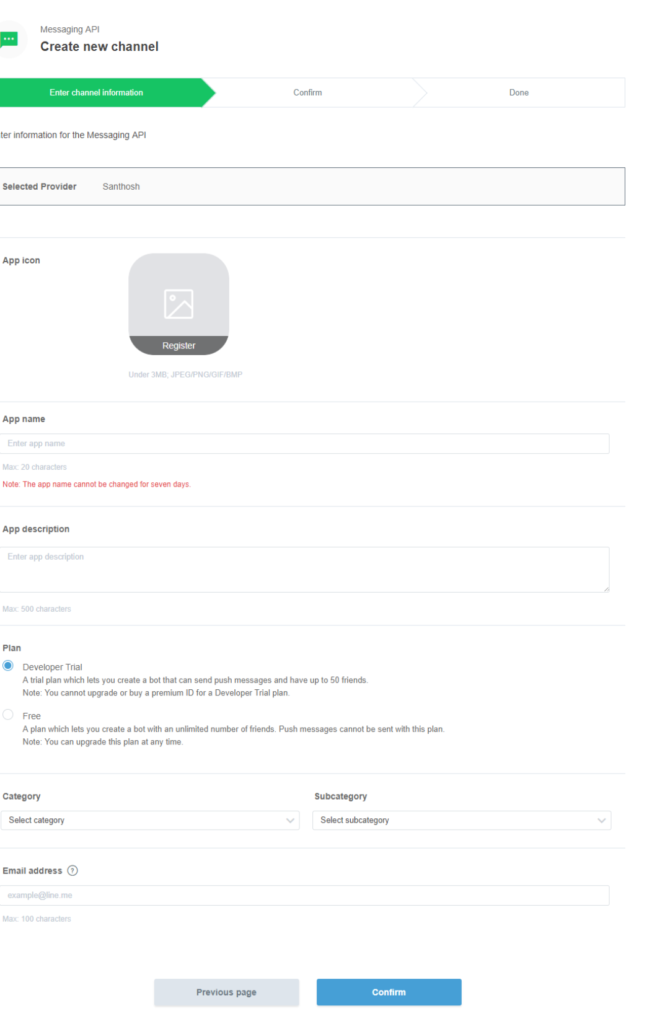Kore.ai 봇에 Line 채널을 추가하려면, Webhook 통합을 설정하여 Line과 Kore.ai 간 통신을 설정해야 합니다. Kore.ai 봇에 Line 채널을 추가하면 봇의 최종 사용자가 사용자의 Line 계정을 사용하여 봇과 상호작용할 수 있습니다. 봇에 Line 채널을 추가하려면, 다음을 수행해야 합니다.
- Create a Provider – Line 채널을 설정하려면, Line 개발자 계정으로 로그인하여 봇에 사용하고자 하는 새 공급자를 생성하거나 공급자를 선택한 후 채널에 추가합니다. Line 채널을 활성화하려면 Line 개발자 포털에서 개발자 계정을 생성하고 등록해야 합니다.
- Enter Channel Information – 앱 아이콘, 앱 이름, 플랜, 카테고리, 하위 카테고리, 이메일 주소와 같은 메시징 API에 대한 채널 정보를 입력합니다.
- Setup Webhook Integration – Kore.ai 봇에 Line 통합을 활성화하려면, 봇 빌더의 Line 채널 Configurations 탭에 있는 Webhook URL을 복사하여 Webhook 통합을 활성화합니다.
- Enable Channel – 봇 빌더에서 통합 설정 및 설정 세부 정보 입력 후에 채널을 활성화해야 합니다.
Line 공급자 생성
- LINE Developer account portal에 로그인합니다.
- 봇에 사용하길 원하는 Provider가 이미 있는 경우 Provider List에서 공급자를 선택합니다.
- Messaging API 섹션에서 Create Channel을 클릭합니다.
- 또는 새 공급자를 추가하려면 Create new provider 옵션을 사용하여 새 공급자를 생성하세요.

- Provider name을 입력하고 새 공급자를 생성합니다.
- 공급자를 생성한 후 Messaging API 섹션에서 Create Channel을 선택하여 채널 추가를 계속합니다.
Line 채널 추가
- Bot Builder의 Bots 섹션에서, Line 채널을 추가할 봇을 클릭하세요.
- Channels 탭에서, LINE 아이콘을 클릭하세요. LINE Channel 페이지가 표시됩니다.
- Enter channel information 필드에서, 필요한 세부 정보를 입력하고 앱 아이콘, 앱 이름, 플랜, 카테고리, 하위 카테고리와 같은 채널을 생성합니다.
- Confirm을 클릭하여 검토하고 채널 생성을 계속합니다.

참고: Kore.ai 플랫폼은 봇의 최종 사용자에게 비대화형 메시지를 보내기 위해 PUSH_MESSAGE를 사용합니다. 이러한 시나리오는 알림 통지, 세션 종료 메시지와 Line 채널의 replyToken을 사용할 수 없거나 만료된 기타 시나리오와 같은 사례를 포함합니다. 이러한 API 호출은 요금이 청구될 수 있습니다. Line 플랜 옵션을 검토하고 필요에 맞는 적절한 플랜을 선택합니다.
채널 세부 정보 확인
-
- 채널이 생성되면 사용 가능한 채널 리스트가 있는 Provider dashboard로 리디렉션됩니다.
- 위에서 생성한 채널을 선택하고 채널 설정을 계속합니다.
- Line 채널의 Channel ID 와 Channel Secret을 확인하고 이 페이지의 Configurations 탭에 입력합니다.
Webhook 통합 활성화
- Webhook 통합을 설정하려면, Messaging Settings 섹션으로 이동하여 Use Webhooks 옵션을 활성화합니다.
- 채널 페이지의 Configurations 탭에 있는 Webhook URL을 복사하여 Webhook URL 필드에 입력합니다.
- Update를 클릭합니다.

- Webhook URL을 저장한 후 Verify를 클릭하여 Line의 Webhook 호출이 Kore.ai 플랫폼에서 수신되는지 확인합니다.
추가 옵션 검토
- Line 채널에서 사용 가능한 그룹 행동과 자동 응답, 인사말 메시지와 같은 추가 옵션을 검토합니다.
- 이 페이지의 Configurations 탭으로 이동하여 설정 과정을 완료합니다.
- Webhook URL: Line이 이미 https://를 포함하고 있음으로 해당 부분을 제외한 URL을 입력합니다.
- 채널 ID: Line 채널의 Channel ID를 확인하여 여기에 입력합니다.
- 채널 시크릿: Line 채널의 Channel Secret을 확인하여 여기에 입력합니다.
Line 채널 편집
Line 채널을 편집하려면 다음 단계를 따르세요.
- 채널 위로 마우스를 이동하고 클릭하여 수정합니다. 채널 설정에서 필요한 업데이트와 저장을 할 수 있습니다.
- 또한 Settings 아이콘을 클릭하여 채널 정보를 사용하지 않거나 삭제할 수도 있습니다.
 채널을 수정하려면 다음과 같은 명령 중 하나를 선택하세요.
채널을 수정하려면 다음과 같은 명령 중 하나를 선택하세요.
- Disable/Enable – Disable을 클릭하여 봇의 Line 채널 사용을 일시적으로 비활성화하세요. Line 채널 사용을 활성화하려면, Enable을 클릭하세요.
- Delete– Delete를 클릭하세요. Delete Confirmation 대화 상자에서, OK을 클릭하여 봇 채널 설정을 영구적으로 삭제합니다.
